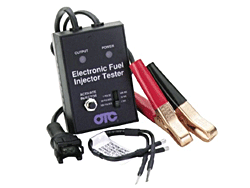Using A Fuel Injector Pulse Tester

Using a Fuel Injector Pulse Tester is the safest way to see if the entire assembly is bad on the CPI ‘Spider’ system (this is because this assembly only has one fuel injector solenoid inside).
Although on the CSFI ‘Spider’ type, you've got 6 or 8 separate fuel injectors, you are still able to test each one with the Fuel Injector Pulse Tester.
How does the Fuel Injector Pulse Tester work? The purpose of the tester is to pulse the fuel injector independent of the vehicle's PCM. In plain English, this is how it's done:
- You connect a fuel pressure gauge to the fuel rail and activate the fuel pump.
- You manually activate the tester to supply power and an activation pulse to the fuel injector.
- Since the tester provides the power and activation signal, there's no need for you to crank the engine.
- The Fuel Injector Pulse Tester has two big alligator clips you connect to your vehicle's battery. This is how the tester get's power and provides power to the fuel injector you're testing.
- The tester has a fuel injector connector that you use to connect to the injector you want to test. In case the tester's connector doesn't fit the particular injectors on your vehicle, the tester comes with a dedicated jumper wire so that you can ‘rig’ up the connection.
- When the fuel injector gets these two signals (from the tester), it has to inject fuel.
- Injecting fuel will cause the fuel pressure value registered on the fuel pressure gauge to drop.
- Seeing this drop or lack of a drop in fuel pressure let's you know if the ‘Spider’ assembly on the CPI is fried or not (this is because the CPI system uses only one fuel injector solenoid within the assembly to feed all of the cylinders -via the nylon fuel lines).
- On the CSFI system, you'll need to test each fuel injector solenoid within the assembly.
Like anything in life, using a Fuel Injector Pulse Tester has advantages and disadvantages.
Let me start out with the advantages:
- This method is safe. No worries about engine damage and the risk of fire is minimized a lot.
- This is the most professional way of testing to see if the ‘Spider’ fuel injector assembly is injecting fuel or not.
Here are the disadvantages:
- This method is not 100% effective.
- On the CPI system, you can't test each individual cylinder's nylon fuel line.
- The tester isn't cheap.
- You need to use a fuel pressure gauge.
- The Fuel Injector Pulse Tester's connector does not fit the ‘Spider’ connectors for the CPI and CSFI. You'll need to rig it up somehow.
Repair And Solution
In conclusion, this is what Jim did to finally get the problem solved:
Solved. I put the new spider in and it fired right up. I never thought that would be it since the old one is only 2-3 years old.
I checked the ohms on the new one which was identical to the old one so I'm assuming it wasn't an electrical failure. Maybe it was mechanical. I plan to dissect the old one just to see if I can figure out why it failed. Thanks for all your help.
Hopefully this case study of Jim's diagnostic and repair experience helps you. If there's any advice you'd like to add or want to contribute your own diagnostic and repair experience, you can use the contact form below:

If this info saved the day, buy me a beer!


